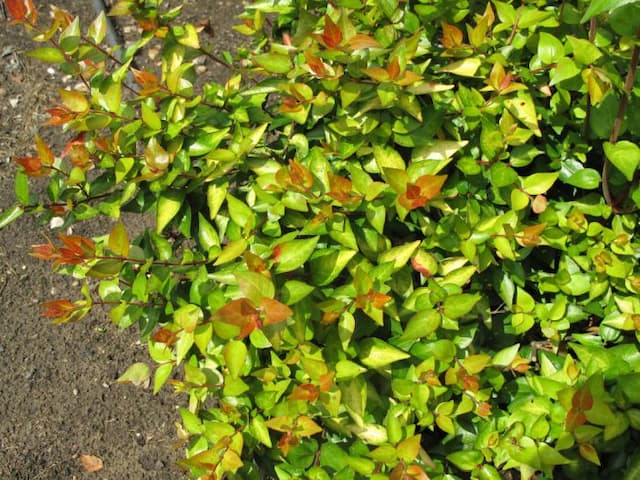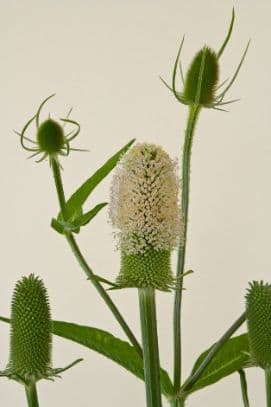Standish's Honeysuckle Lonicera standishii var. lancifolia 'Budapest'

ABOUT
The Lonicera standishii var. lancifolia 'Budapest', also known as Winter Honeysuckle, is a deciduous shrub characterized by its fragrant, cream-white flowers which bloom in the heart of winter and early spring. These flowers are small, tubular in shape, and usually appear before the leaves. The plant's branches are adorned with narrow, lance-shaped leaves that have a soft, bluish-green hue. The foliage provides a lush backdrop for the delicate flowers, which emit a sweet aroma that attracts various pollinators, even in cold weather. As the season progresses into late spring and summer, these flowers give way to small, red berries, adding another layer of visual interest to the shrub. The overall appearance of the Winter Honeysuckle is one of rustic natural beauty, with an informal growth habit, and it serves as both an attractive and aromatic addition to gardens.
About this plant
 Names
NamesFamily
Caprifoliaceae.
Synonyms
Standish's Honeysuckle, Budapest Honeysuckle, Winter Honeysuckle, Fragrant Honeysuckle.
Common names
Lonicera standishii var. lancifolia 'Budapest'
 Toxicity
ToxicityTo humans
The Lonicera standishii var. lancifolia 'Budapest', commonly known as Honeysuckle, may contain saponins and glycosides, which can be mildly toxic if ingested in significant quantities. Symptoms of honeysuckle poisoning may include stomach upset, diarrhea, and vomiting. In some cases, ingesting honeysuckle can lead to more severe symptoms such as rapid heartbeat or respiratory distress, though such severe reactions are rare. If any parts of the plant are consumed, it is advisable to seek medical attention.
To pets
For pets, Honeysuckle can also be toxic. The saponins and glycosides found in this plant can cause similar symptoms to those in humans, such as vomiting, diarrhea, and general stomach upset. In severe cases, more intense symptoms like difficulty in breathing or an increased heart rate can occur. If you suspect your pet has ingested honeysuckle, you should contact a veterinarian immediately.
 Characteristics
CharacteristicsLife cycle
Perennials
Foliage type
Deciduous
Color of leaves
Green
Flower color
White
Height
6 feet (1.83 meters)
Spread
6 feet (1.83 meters)
Plant type
Shrub
Hardiness zones
5
Native area
China
Benefits
 General Benefits
General Benefits- Ornamental Appeal: Lonicera standishii var. lancifolia 'Budapest', commonly known as Standish's honeysuckle, offers ornamental value to gardens with its attractive flowers and foliage.
- Wildlife Attraction: Its flowers are a source of nectar for pollinators, such as bees and butterflies, which can help increase biodiversity in the area.
- Scented Flowers: Standish's honeysuckle is known for its sweetly-scented blooms, which can provide a pleasant fragrance to the garden setting.
- Privacy and Screening: With its dense growth habit, it can be used for privacy screening or as a hedge to define garden spaces.
- Low Maintenance: Typically, this plant requires minimal care once established, which is beneficial for gardeners seeking low-maintenance landscaping options.
- Winter Interest: Many cultivars, including 'Budapest', have notable winter interest due to their persistent berries and sometimes evergreen foliage, depending on the climate.
- Drought Tolerance: Once established, Standish's honeysuckle exhibits a degree of drought tolerance, making it suitable for xeriscaping or dry environments.
- Tolerant of Different Soil Types: This plant is adaptable to a variety of soil types, reducing the need for soil amendments and special care.
- Erosion Control: The rooting system of Standish's honeysuckle can help in stabilizing slopes and controlling soil erosion.
 Medical Properties
Medical PropertiesThis plant is not used for medical purposes.
 Air-purifying Qualities
Air-purifying QualitiesThis plant is not specifically known for air purifying qualities.
 Other Uses
Other Uses- Lonicera standishii var. lancifolia 'Budapest', commonly known as Standish honeysuckle, can be used as a natural fence or privacy screen due to its dense foliage.
- In garden design, the arching branches of Standish honeysuckle can be trained onto trellises or pergolas to create living archways or shaded areas.
- The plant's vigorous growth habit makes it suitable for rehabilitating areas with soil erosion by stabilizing the soil with its roots system.
- With pruning and training, Standish honeysuckle can be grown as a topiary, offering a unique and ornamental twist in the garden.
- The flowers can be a source of nectar for DIY nectar solutions when creating feeders for butterflies or hummingbirds.
- Standish honeysuckle's branches can be used in floral arrangements for rustic or wild-themed bouquets, bringing a natural outdoor element indoors.
- This variety of honeysuckle can be used in sensory gardens, providing fragrance and encouraging wildlife to aid in a sensory experience.
- In crafting, the flexible stems of young plants may be used for making wreaths or other decorative items.
- When dried, the seed pods and spent blooms can be incorporated into potpourris for a subtle, natural scent.
- The dense twining growth habit of Standish honeysuckle provides shelter and nesting opportunities for small birds and insects.
Interesting Facts
 Feng Shui
Feng ShuiThe Standish Honeysuckle is not used in Feng Shui practice.
 Zodiac Sign Compitability
Zodiac Sign CompitabilityThe Standish Honeysuckle is not used in astrology practice.
 Plant Symbolism
Plant Symbolism- Love and Devotion: As a variety of honeysuckle, Lonicera standishii 'Budapest' often symbolizes love and devoted affection. Honeysuckle has been traditionally associated with the strong bonds of love, possibly because of its twining nature and its sweet fragrance that can attract others.
- Generosity: The abundance of flowers produced by the plant is often seen as a symbol of generosity and giving without expectation of return.
- Bonds of Friendship: The intertwining growth pattern of Lonicera standishii 'Budapest' also makes it emblematic of the close ties and connections between friends. It can represent the intertwined lives and mutual support within friendships.
- Everlasting Bonds: Its perennial nature signifies lasting and enduring connections, whether they be familial, romantic, or platonic.
- Protection: Historically, honeysuckles were planted near homes with the belief that they would prevent negative energies from entering, thus symbolizing protection and safety.
- Happy Homes: The sweet scent and vibrant growth habit of Lonicera standishii 'Budapest' are often associated with creating a pleasant and inviting home environment, pointing to happiness within the household.
 Water
WaterThe Standish's honeysuckle should be watered deeply to ensure moisture reaches the root zone, typically administering about 1 to 1.5 gallons for an established plant every week during the growing season. Adjust the frequency to account for rainfall, and during hot, dry spells, you might need to water twice a week. In the winter, reduce watering since the plant requires less moisture when dormant. Avoid overhead watering to prevent leaf diseases; instead, use a soaker hose or water at the base of the plant.
 Light
LightStandish's honeysuckle thrives in full sun to partial shade. The ideal location is where the plant can receive at least six hours of sunlight daily, but it can also tolerate some afternoon shade. Avoid deeply shaded areas as this can affect flowering and overall health.
 Temperature
TemperatureStandish's honeysuckle can survive in temperatures as low as -20°F and as high as 90°F, but it prefers a range between 60°F and 75°F. These temperature ranges are ideal for robust growth and flowering. The plant is hardy and can tolerate the cold winters in most temperate regions.
 Pruning
PruningPrune Standish's honeysuckle to shape the plant, encourage bushier growth, and remove any dead or diseased branches. The best time to prune is after flowering, typically in late winter or early spring, to maintain an attractive shape and promote vigorous blooms for the coming season. Prune lightly, as severe pruning can reduce the number of flowers.
 Cleaning
CleaningNot needed
 Soil
SoilStandish Honeysuckle prefers well-drained soil with rich organic matter. A blend of loam, peat, and sand in equal parts works well, ensuring efficient drainage and aeration. It thrives at a soil pH of around 6.0 to 7.5.
 Repotting
RepottingStandish Honeysuckle does not typically require frequent repotting. It should be repotted every 2-3 years or when it outgrows its current container, using the same well-draining soil mix.
 Humidity & Misting
Humidity & MistingStandish Honeysuckle is adaptable but prefers moderate to high humidity levels, ensuring that the plant does not endure overly dry air which can lead to stress.
 Suitable locations
Suitable locationsIndoor
Provide bright, indirect light and ensure good air circulation.
Outdoor
Position in sun to partial shade with shelter from harsh elements.
Hardiness zone
5-9 USDA
 Life cycle
Life cycleThe Lonicera standishii var. lancifolia 'Budapest', commonly known as the Standish's Honeysuckle, begins its life cycle as a seed that germinates in the soil after experiencing a period of cold stratification, which simulates winter conditions. Once germinated, the seedling emerges and, given adequate light and moisture, will grow into a young plant with a developing root system and foliage. As it matures, it enters a vegetative stage, producing dense, deciduous leaves and long, twining stems that allow it to climb on supports or spread across the ground. Standish's Honeysuckle reaches reproductive maturity typically within a few years, and in late winter to early spring, it produces fragrant white flowers that mature to a creamy yellow, attracting pollinators such as bees and butterflies. Following pollination, the flowers develop into small red to black berries, which are dispersed by birds and other wildlife, thus completing the reproductive cycle. As a perennial, the plant will undergo dormancy during the cold winter months, shedding leaves and conserving energy until the warmer spring temperatures trigger the next growing cycle.
 Propogation
PropogationPropogation time
Spring to Summer
The Lonicera standishii var. lancifolia 'Budapest', commonly known as Standish's Honeysuckle, is often propagated by semi-hardwood cuttings. This method is typically done during the summer months when the plant has finished its primary growth phase and the stems are partially matured but still flexible. To propagate, a cutting of about 4 to 6 inches (approximately 10 to 15 centimeters) in length is taken from a healthy parent plant. The lower leaves are removed and the cut end is dipped in rooting hormone to encourage root development. The cutting is then placed in well-draining potting mix, ensuring that the node where the leaves were removed is buried as roots tend to form at these points. The potting environment should be kept moist and the cutting should be placed in indirect sunlight until roots have established, after which the new plant can be gradually acclimated to more direct light and eventually transplanted outdoors.








